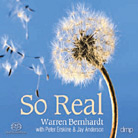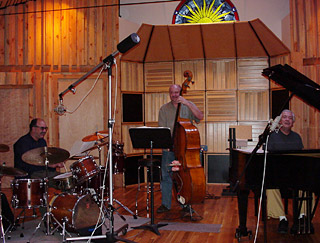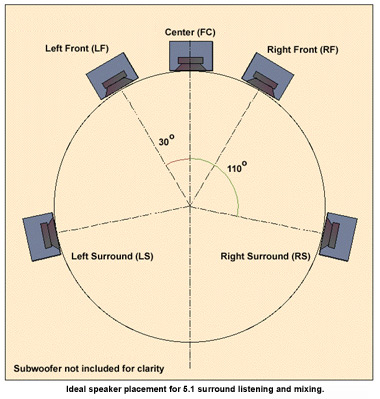![[SoundStage!]](../sslogo3.gif) Surrounded! Surrounded!Back Issue Article |
|
April 2002 An Interview with Tom Jung of DMP Tom Jung is the president and recording/mastering engineer of DMP (Digital Music Products) Records, and he is a technical consultant for Pro Audio Review. Tom has helped pioneer multichannel recordings in Sony’s SACD format.Jeff Fritz: Tell us a bit about how you got started as a recording engineer and the history behind DMP Records. Tom Jung: I started as a disc-cutting engineer at a studio in Minneapolis. This was a full-service studio that even had its own pressing plant. After a few short months I got involved in location recording of bands and choirs as well as studio recordings of every type of music from rock ‘n roll to polka. In the mid-'70s, engineers from the 3M Company brought their prototype digital recorder over from St. Paul to do some field testing. The result of this testing turned out to be the beginning of an idea that turned into Digital Music Products (DMP). Having been involved with all of the problems inherent in making a good LP, the idea of a digital delivery system was very appealing to me. In 1979, we packed up the kids and headed for New York, where I worked as a freelance engineer recording movie scores, jingles, and records. This was a great period in my career as it allowed me to work with some of the best musicians in the world in the New York studio scene. Many of these musicians turned out to be DMP artists. In 1983 (birth of the CD), DMP released what turned out to be the first two jazz CDs on the planet. JF: What valuable lessons did you learn early on that have proven invaluable in your career? TJ: That you can never stop learning. JF: What would you deem the most significant advances in recording technology over the course of your career? TJ: It would have to be the switch from analog to digital. Unfortunately, it took me several years to figure out what was wrong with PCM. I went from 16-bit to 18-bit to 19-bit to 20-bit, and even 24-bit digital before I realized PCM had some inherent problems. I came away from almost every PCM session less than satisfied technically and couldn’t figure out why. Then along came DSD (Direct Stream Digital), which seemed to address most of the problems I was having trying to get PCM to sound right.
JF: How did you get involved with SACD? TJ: About five or six years ago David Kawakami from Sony invited Bob Ludwig, Bruce Swedien, Mike Bishop, and me to a demonstration at Sony Music Studios in New York. They had a live jazz quartet in the studio and we were able to listen to the live microphone feed, and a couple different versions of PCM and DSD. Switching back and forth it was obvious to all of us that DSD sounded more like the microphone feed than any other format. PCM didn’t even come close. It hit me like a ton of bricks, sort of like it did back in Minnesota with that first digital recorder. I pestered David Kawakami until he let me use the two-channel DSD prototype recorder on a session. I should point out that in the early days of DMP all of our projects were recorded live to two track, and so going back to this style of recording turned out to be a real treat. On that first DSD session we also ran a 24-bit/96kHz Nagra D PCM machine. We did extensive listening tests afterwards, and I realized that I would never go back to PCM again, no matter what bit or sample rate. JF: What advantages does multichannel offer, both to the engineer and the end user? TJ: Recording music in multichannel allows the engineer a greater opportunity to get what was happening at the session into the end-user’s listening space. For music that is fabricated track by track, which is true of almost all of pop music these days, a true live performance never exists, so a multichannel mix has to be made up of dozens of tracks panned and manipulated into something that represents some sort of virtual performance. With our latest multichannel SACD releases I have simply used six microphones assigned to six channels of a DSD recorder, no panning, no overdubs, and no fix-it-in-the-mix. These recordings are the most satisfying recordings I have made to date and represent what can happen when great musicians are captured in a simple and pristine way. JF: What is the biggest challenge to recording in multichannel? TJ: Trying to figure out what
kind of system the recordings I am making are going to be played back on. I have used the
ITU* multichannel standard for monitoring, but feel that many people are not using it for
playback. This standard calls for five identical speakers equidistant from the listener,
with left- and right-front at 30 degrees from center, and left- and right-surround at 110
degrees from center. JF: What type of music do you most enjoy at home? TJ: Mostly classical, jazz, and pop. JF: Over what type of system do you listen? TJ: My studio is in my home, so that is the system I listen to. It has six SLS Ribbon Monitors powered by a Sunfire Cinema Grand Signature multichannel amplifier. The front-end consists of a Philips professional multichannel SACD player feeding an EMMLabs eight-channel D-to-A converter, which in turn feeds an EMMLabs Switchman controller/preamp. JF: Looking into your crystal ball, where do you see recorded music in ten years? TJ: I think many formats will co-exist, all the way from crummy-sounding MP3-type lossy-compressed formats to the compact disc we have today to SACD, maybe even at a higher bit rate. JF: What projects can we expect from DMP Records in the future? What are you looking most forward to? TJ: I’m currently in the planning stages on two new SACD recordings. *The ITU (International Telecommunication Union) was established in 1865, less than 30 years after the introduction of the telegraph. The purpose of the ITU has been to establish standards and regulations for the telecommunication industry. The ITU today consists of three branches, the Radio Communication Sector, Standardization Sector, and the Development Sector. The ITU’s membership is comprised of both international governments and private organizations. There are currently 189 member states and 650 sector members. Secretaried by Yoshio Utsumi, the ITU is based in Geneva, Switzerland.
|
|
|
|
![[SoundStage!]](../sslogo3.gif) All Contents All ContentsCopyright © 2002 SoundStage! All Rights Reserved |


 The center surround speaker I have been recording fits nicely in at 180 degrees
and adds yet another dimension. I do not use an LFE or .1 channel.
The center surround speaker I have been recording fits nicely in at 180 degrees
and adds yet another dimension. I do not use an LFE or .1 channel.